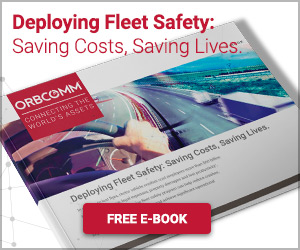
Driving Fleet Safety and Performance with Telematics
- Blog
- Transportation
- Driving Fleet Safety and Performance with Telematics
- Jun 21, 2018
- Cody Lirette
 There’s been a lot of coverage in the media recently about commercial vehicle telematics thanks to the new ELD (Electronic Logging Device) mandate that came into effect last December by FMCSA, the US Federal Motor Carrier Safety Administration. The new rule, fully enforced from April 1, affects all professional drivers and motor carriers who are required to prepare hours-of-service (HOS) records of duty status (RODS), although fleets with existing automated on-board recording devices (AOBRDs) have until December 2019 to upgrade. Finding a trusted telematics solution is top of mind for many carriers as a result.
There’s been a lot of coverage in the media recently about commercial vehicle telematics thanks to the new ELD (Electronic Logging Device) mandate that came into effect last December by FMCSA, the US Federal Motor Carrier Safety Administration. The new rule, fully enforced from April 1, affects all professional drivers and motor carriers who are required to prepare hours-of-service (HOS) records of duty status (RODS), although fleets with existing automated on-board recording devices (AOBRDs) have until December 2019 to upgrade. Finding a trusted telematics solution is top of mind for many carriers as a result.
But regulatory compliance is only a part of the telematics story. Fleets of all shapes and sizes – from light vehicles up to the most heavy-duty haulage – can benefit from significant increases in driver performance, safety and operational effectiveness by correctly selecting and implementing a telematics solution, regardless of whether they are affected by the ELD rule or not. That’s especially the case for anyone working in and with the high risk- and safety-conscious hydrocarbon and mineral extraction industries, where compliance is simply a given and a “license to operate.”
So, should you be investing in telematics, what should you expect and demand from your solution and how can you ensure maximum return on investment?
Telematics – not just for transportation companies
Firstly, let’s dispel the myth that companies who don’t consider themselves primarily to be transportation providers won’t get a benefit from telematics. Take a look at how much your business depends on drivers and vehicles and think about how much time your people spend driving even when it is not their core function. Of the many activities required of employees, driving is one where there are relatively few safety barriers between doing something right and something wrong. And the consequences of doing something wrong while driving on a public highway can be far-reaching.
The right telematics solution enables you to actively monitor and measure what’s happening with your personnel while out on the road and – most importantly of all – the opportunity to provide proactive coaching and advice to improve driving behaviors. Over many years of developing and implementing transport telematics in the oil, gas and other industries, we’ve had chance to analyze, systemize and calibrate what constitutes professional driving. These best practice settings – including acceleration, deceleration, braking, speed, turns, anticipation (time between taking foot off accelerator and putting it down on the brake) plus a myriad of other factors – are embedded in the system.
As a result, driver feedback can be positive and fact-based versus punitive and ‘best guess.’ This is one of the fundamental benefits of having an advanced telematics system, and equally critical for getting the best out of your technology investment.
People will make mistakes and it’s all too easy for these mistakes to compound and fall into bad habits. Having a trusted telematics solution that…
- Alerts and advises when driving behavior is ‘out of preferred practice’,
- Allows drivers to self-correct and
- Provides the basis for a fact-based review with a supervisor
…has been proven to yield substantial improvements in driving performance.
Not only does this improve safety; it also leads to less vehicle wear and tear, better fuel economy and higher productivity.
Along the way, we’ve identified two key factors that are crucial to trusted telematics:
Speed by street
Continually mapping and remapping street-level speed zones across North America and other countries where our customers operate ensures on the one hand that drivers are not unfairly punished for speeding and on the other that speeding is identified in any situation. It’s not much use only recording top speed when your driver is going 28mph in a 25mph zone – that’s still a violation.
Having speed zones on the device versus in the cloud is also a subtle but critical aspect to consider. It’s the difference between a driver receiving feedback immediately versus potentially after the event due to communication latency. Feedback delay creates confusion and has a detrimental impact on the existing safety program in place. To be a competent safety barrier, feedback needs to be swift, certain and ideally positive.
Voice mentoring
Giving drivers an immediate voice indication when they breach one of many mapped antecedent behaviors – similar to using Google Maps navigation – is viewed very positively compared to a ‘beep’ or a ‘buzzer’ and fosters swift self-corrective behavior. The driver understands immediate cause and effect and can immediately reflect on the act or omission that created the event. This combined with Speed by Street provides a comprehensive and competent behavior-based solutions to mitigate behaviors associated with speeding.
But like any other technology, telematics is an enabler, not a panacea. It cannot transform businesses on its own but rather needs to be integrated into a holistic compliance and performance culture. If drivers consistently make mistakes and these are not picked up and addressed, that sub-par behavior will become normalized very quickly. So, there must be an organizational solution supporting the data or it will rapidly become a white elephant. Key measures to ensure integration include training drivers about the ‘why and the how’ and training supervisors to provide feedback in ‘context coaching’ methodology.
Making the move to management by exception
While telematics effectiveness depends on gathering a huge amount of raw data, an effective telematics solution needs to help companies shift to management by exception, ensure that different users only see the data that is relevant to them, and push data into the systems and format that users want – not the other way around. So, understanding the types of dashboard reports available, and how the system can be configured and customized, is crucial when considering an investment.
It’s all about setting up the right reports that give people the data they need at the frequency they need it. C-suite executives for instance generally want a dashboard pushed to a place that suits them that gives them a top-level view of trends. The DOT compliance manager wants to know about who is and who is not compliant. And the HSE person is mainly interested in the exceptions and the context of that exception that could indicate HSE exposure, such as speeding, harsh turns and sharp acceleration/deceleration.
Properly implemented, with right organizational framework, culture and support, a trusted telematics solution can help companies hold their people respectfully accountable, providing quantifiable safety and performance metrics versus guesswork, and identifying the who, what, when, where and how that create an opening for improvement. Compliance is just the start.

Cody Lirette is Senior Content Marketing Manager at ORBCOMM. With over a decade of marketing and communications experience for both the public and private sector, he uses his passion for innovative technology and plain language to build compelling content that inspires action.

















